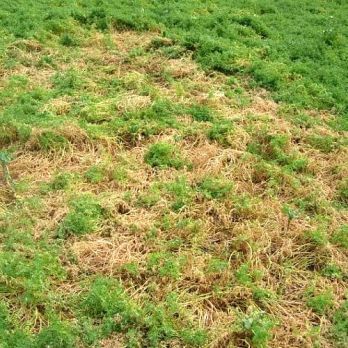Crop Watch October (no. 2) 2022

Botrytis disease in lentil and faba bean
Botrytis grey mould (BGM) of lentil and chocolate spot (CS) of faba bean has been reported across all growing regions of South Australia. Optimal conditions for these diseases include mild temperatures (15-25°C) and persistent high humidity extending over 4 to 5 days or more. The forecast for frequent rain events means conditions will remain conducive for further disease development. Even when the rain stops, heavy canopies will draw humidity from wet soil, leading to high infection rates and disease spread.
BGM in lentils appears initially as small white lesions often becoming pale grey or tan but without black spots in the centre. Grey fluffy fungal mycelium may be easily visible in affected crops under the canopy when parting the crop for inspections. The disease can infect leaves, stems, pods and flowers and can cause flower and pod abortion and plant death.
CS in faba beans starts as small speckled reddish-brown spots scattered over leaves and stems. Flower infection is a distinguishing characteristic. Once CS is established in a crop it can spread rapidly and the lesions can coalesce leaving large black or grey blotches, killing plants.
Management of botrytis disease
Growers across the state are urged to monitor their paddocks for BGM and CS, particularly under powerlines or around trees where previous fungicide sprays may not have given complete coverage as these can become hotspots for disease. Growers are recommended to implement foliar fungicide regimes where necessary.
Faba bean
All varieties are currently rated MS or S except for PBA Amberley which is rated MRMS. Fungicide sprays for chocolate spot in faba beans should be applied at approximately 2 to 3-week intervals in varieties rated MS or S. PBA Amberley will still require sprays to control CS disease especially in high rainfall situations . Flowers are especially at risk of infection leading to flower loss. Pod infection and seed abortion can also occur if crops are left untreated.
Lentil
All lentil crops will require fungicide sprays to protect against BGM in the current weather conditions. Varieties rated MRMS to BGM (for example, PBA KelpieXT, GIA Thunder, GIA Metro) or those rated MS (for example, PBA Hurricane XT, PBA Highland XT, GIA Sire) may require fortnightly sprays to control the disease. Varieties rated RMR (PBA Jumbo2) or MR (PBA Hallmark XT, GIA Leader) may require sprays at 3 to 4 weekly intervals as the current seasonal conditions create a high risk for the disease to overcome the varietal resistance.
Growers are reminded to:
- adhere to label rates
- mix and rotate fungicide groups
- note that same fungicides can only be sprayed twice per season in a crop.
View the 2022 fungicide guides for pulse crops on the Pulse Australia website.
For diagnostic advice about BGM or CS, contact
Sara Blake
Phone: (08) 8429 2248
Email: sara.blake@sa.gov.au
or email pirsa.sardipulsepathology@sa.gov.au.
Sclerotina in lentil
Sclerotinia disease is appearing in lentil crops in several South Australian regions following the ongoing showery conditions. This disease affects pulses, canola, weed and pasture species as well as brassica vegetables, but not cereals. Sclerotinia is promoted in wet seasons or regions and under intensive pulse and or canola cropping . Warm dry weather will halt spread of the disease but rain will continue the spread.
The disease appears as white cottony fungal growth on the stems, branches, leaves, flowers and pods, and can girdle the stem or branch killing the plant parts above the lesion. Initially a small number of plants may be affected without turning yellow before wilting then dying rapidly. In conducive disease conditions, large areas of the crop can become affected and die. The pathogen(s) survive for several years in and on the soil as hard black sclerotia (2–8 mm) which look like rat droppings. Sclerotia can be produced on and in infected stems or pod cavities, or within the cottony fungal growth.
Management of sclerotinia disease
There are currently no pulse resistance ratings for sclerotinia disease and there are a limited number of fungicides registered for control of sclerotinia in pulses. Widening rotations between host crops can help reduce the inoculum levels in the following year.
A new 4-year co-investment between the Grains Research Development Corporation (GRDC) and NSW Department of Primary Industries (lead agency), South Australian Research and Development Institute (SARDI), Agriculture Victoria, University of Queensland and Marcroft Grains Pathology will investigate disease epidemiology and management of sclerotinia in pulses with SARDI focusing on lentil.
A recent publication Sclerotinia in Victorian Pulses by Agriculture Victoria provides useful information for disease control.
For diagnostic advice about sclerotinia in pulses and to provide samples for research, contact
Sara Blake
Phone: (08) 8429 2248
Email: sara.blake@sa.gov.au
or email pirsa.sardipulsepathology@sa.gov.au.
Stay up to date with the latest disease-related issues and solutions for broadacre crops during the growing season.








